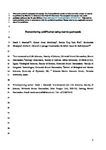Biomonitoring acidification using marine gastropods
| dc.contributor.author | Marshall, DJ | |
| dc.contributor.author | Abdelhady, AA | |
| dc.contributor.author | Wah, DTT | |
| dc.contributor.author | Mustapha, N | |
| dc.contributor.author | Gӧdeke, SH | |
| dc.contributor.author | De Silva, LC | |
| dc.contributor.author | Hall-Spencer, Jason | |
| dc.date.accessioned | 2019-10-22T10:23:11Z | |
| dc.date.issued | 2019-11-20 | |
| dc.identifier.issn | 0048-9697 | |
| dc.identifier.issn | 1879-1026 | |
| dc.identifier.uri | http://hdl.handle.net/10026.1/15006 | |
| dc.description.abstract |
Ocean acidification is mainly being monitored using data loggers which currently offer limited coverage of marine ecosystems. Here, we trial the use of gastropod shells to monitor acidification on rocky shores. Animals living in areas with highly variable pH (8.6-5.9) were compared with those from sites with more stable pH (8.6-7.9). Differences in site pH were reflected in size, shape and erosion patterns in Nerita chamaeleon and Planaxis sulcatus. Shells from acidified sites were shorter, more globular and more eroded, with both of these species proving to be good biomonitors. After an assessment of baseline weathering, shell erosion can be used to indicate the level of exposure of organisms to corrosive water, providing a tool for biomonitoring acidification in heterogeneous intertidal systems. A shell erosion ranking system was found to clearly discriminate between acidified and reference sites. Being spatially-extensive, this approach can identify coastal areas of greater or lesser acidification. Cost-effective and simple shell erosion ranking is amenable to citizen science projects and could serve as an early-warning-signal for natural or anthropogenic acidification of coastal waters. | |
| dc.format.extent | 833-843 | |
| dc.format.medium | Print-Electronic | |
| dc.language | en | |
| dc.language.iso | en | |
| dc.publisher | Elsevier | |
| dc.subject | Ocean acidification | |
| dc.subject | Bioindicators | |
| dc.subject | Acid sulphate soils | |
| dc.subject | Calcification | |
| dc.subject | Snails | |
| dc.subject | Tropical | |
| dc.title | Biomonitoring acidification using marine gastropods | |
| dc.type | journal-article | |
| dc.type | Journal Article | |
| plymouth.author-url | https://www.webofscience.com/api/gateway?GWVersion=2&SrcApp=PARTNER_APP&SrcAuth=LinksAMR&KeyUT=WOS:000484994700080&DestLinkType=FullRecord&DestApp=ALL_WOS&UsrCustomerID=11bb513d99f797142bcfeffcc58ea008 | |
| plymouth.volume | 692 | |
| plymouth.publication-status | Published | |
| plymouth.journal | Science of the Total Environment | |
| dc.identifier.doi | 10.1016/j.scitotenv.2019.07.041 | |
| plymouth.organisational-group | /Plymouth | |
| plymouth.organisational-group | /Plymouth/Faculty of Science and Engineering | |
| plymouth.organisational-group | /Plymouth/Faculty of Science and Engineering/School of Biological and Marine Sciences | |
| plymouth.organisational-group | /Plymouth/PRIMaRE Publications | |
| plymouth.organisational-group | /Plymouth/REF 2021 Researchers by UoA | |
| plymouth.organisational-group | /Plymouth/REF 2021 Researchers by UoA/UoA07 Earth Systems and Environmental Sciences | |
| plymouth.organisational-group | /Plymouth/Research Groups | |
| plymouth.organisational-group | /Plymouth/Research Groups/Marine Institute | |
| plymouth.organisational-group | /Plymouth/Users by role | |
| plymouth.organisational-group | /Plymouth/Users by role/Academics | |
| dc.publisher.place | Netherlands | |
| dcterms.dateAccepted | 2019-07-03 | |
| dc.rights.embargodate | 2020-7-14 | |
| dc.identifier.eissn | 1879-1026 | |
| dc.rights.embargoperiod | Not known | |
| rioxxterms.versionofrecord | 10.1016/j.scitotenv.2019.07.041 | |
| rioxxterms.licenseref.uri | http://www.rioxx.net/licenses/all-rights-reserved | |
| rioxxterms.licenseref.startdate | 2019-11-20 | |
| rioxxterms.type | Journal Article/Review |


